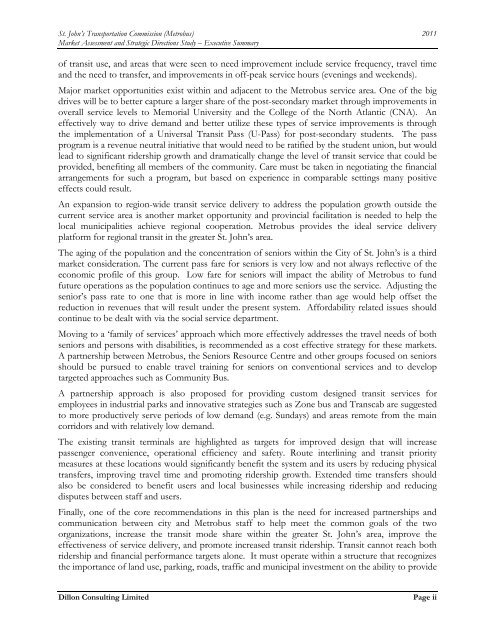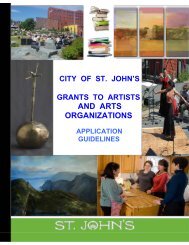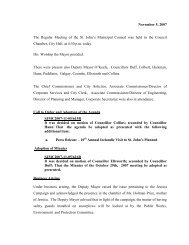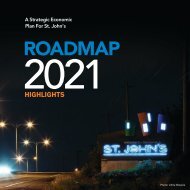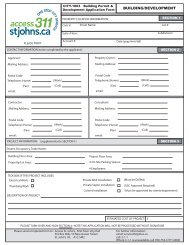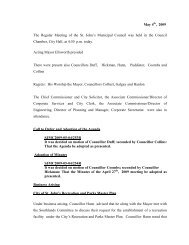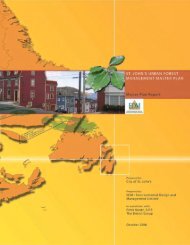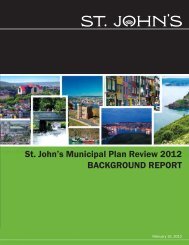Metrobus Transit Study.pdf - City of St. John's
Metrobus Transit Study.pdf - City of St. John's
Metrobus Transit Study.pdf - City of St. John's
Create successful ePaper yourself
Turn your PDF publications into a flip-book with our unique Google optimized e-Paper software.
<strong>St</strong>. John’s Transportation Commission (<strong>Metrobus</strong>) 2011<br />
Market Assessment and <strong>St</strong>rategic Directions <strong><strong>St</strong>udy</strong> – Executive Summary<br />
<strong>of</strong> transit use, and areas that were seen to need improvement include service frequency, travel time<br />
and the need to transfer, and improvements in <strong>of</strong>f-peak service hours (evenings and weekends).<br />
Major market opportunities exist within and adjacent to the <strong>Metrobus</strong> service area. One <strong>of</strong> the big<br />
drives will be to better capture a larger share <strong>of</strong> the post-secondary market through improvements in<br />
overall service levels to Memorial University and the College <strong>of</strong> the North Atlantic (CNA). An<br />
effectively way to drive demand and better utilize these types <strong>of</strong> service improvements is through<br />
the implementation <strong>of</strong> a Universal <strong>Transit</strong> Pass (U-Pass) for post-secondary students. The pass<br />
program is a revenue neutral initiative that would need to be ratified by the student union, but would<br />
lead to significant ridership growth and dramatically change the level <strong>of</strong> transit service that could be<br />
provided, benefiting all members <strong>of</strong> the community. Care must be taken in negotiating the financial<br />
arrangements for such a program, but based on experience in comparable settings many positive<br />
effects could result.<br />
An expansion to region-wide transit service delivery to address the population growth outside the<br />
current service area is another market opportunity and provincial facilitation is needed to help the<br />
local municipalities achieve regional cooperation. <strong>Metrobus</strong> provides the ideal service delivery<br />
platform for regional transit in the greater <strong>St</strong>. John’s area.<br />
The aging <strong>of</strong> the population and the concentration <strong>of</strong> seniors within the <strong>City</strong> <strong>of</strong> <strong>St</strong>. John’s is a third<br />
market consideration. The current pass fare for seniors is very low and not always reflective <strong>of</strong> the<br />
economic pr<strong>of</strong>ile <strong>of</strong> this group. Low fare for seniors will impact the ability <strong>of</strong> <strong>Metrobus</strong> to fund<br />
future operations as the population continues to age and more seniors use the service. Adjusting the<br />
senior’s pass rate to one that is more in line with income rather than age would help <strong>of</strong>fset the<br />
reduction in revenues that will result under the present system. Affordability related issues should<br />
continue to be dealt with via the social service department.<br />
Moving to a ‘family <strong>of</strong> services’ approach which more effectively addresses the travel needs <strong>of</strong> both<br />
seniors and persons with disabilities, is recommended as a cost effective strategy for these markets.<br />
A partnership between <strong>Metrobus</strong>, the Seniors Resource Centre and other groups focused on seniors<br />
should be pursued to enable travel training for seniors on conventional services and to develop<br />
targeted approaches such as Community Bus.<br />
A partnership approach is also proposed for providing custom designed transit services for<br />
employees in industrial parks and innovative strategies such as Zone bus and Transcab are suggested<br />
to more productively serve periods <strong>of</strong> low demand (e.g. Sundays) and areas remote from the main<br />
corridors and with relatively low demand.<br />
The existing transit terminals are highlighted as targets for improved design that will increase<br />
passenger convenience, operational efficiency and safety. Route interlining and transit priority<br />
measures at these locations would significantly benefit the system and its users by reducing physical<br />
transfers, improving travel time and promoting ridership growth. Extended time transfers should<br />
also be considered to benefit users and local businesses while increasing ridership and reducing<br />
disputes between staff and users.<br />
Finally, one <strong>of</strong> the core recommendations in this plan is the need for increased partnerships and<br />
communication between city and <strong>Metrobus</strong> staff to help meet the common goals <strong>of</strong> the two<br />
organizations, increase the transit mode share within the greater <strong>St</strong>. John’s area, improve the<br />
effectiveness <strong>of</strong> service delivery, and promote increased transit ridership. <strong>Transit</strong> cannot reach both<br />
ridership and financial performance targets alone. It must operate within a structure that recognizes<br />
the importance <strong>of</strong> land use, parking, roads, traffic and municipal investment on the ability to provide<br />
Dillon Consulting Limited<br />
Page ii


